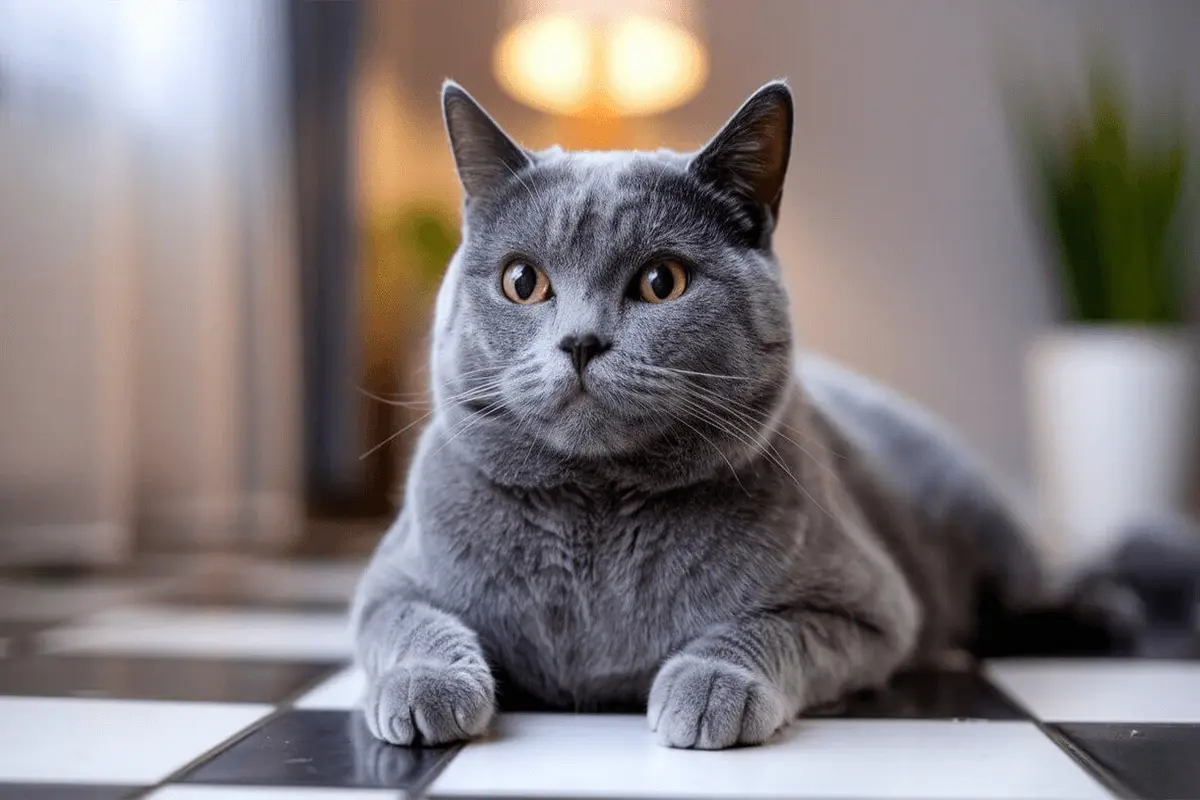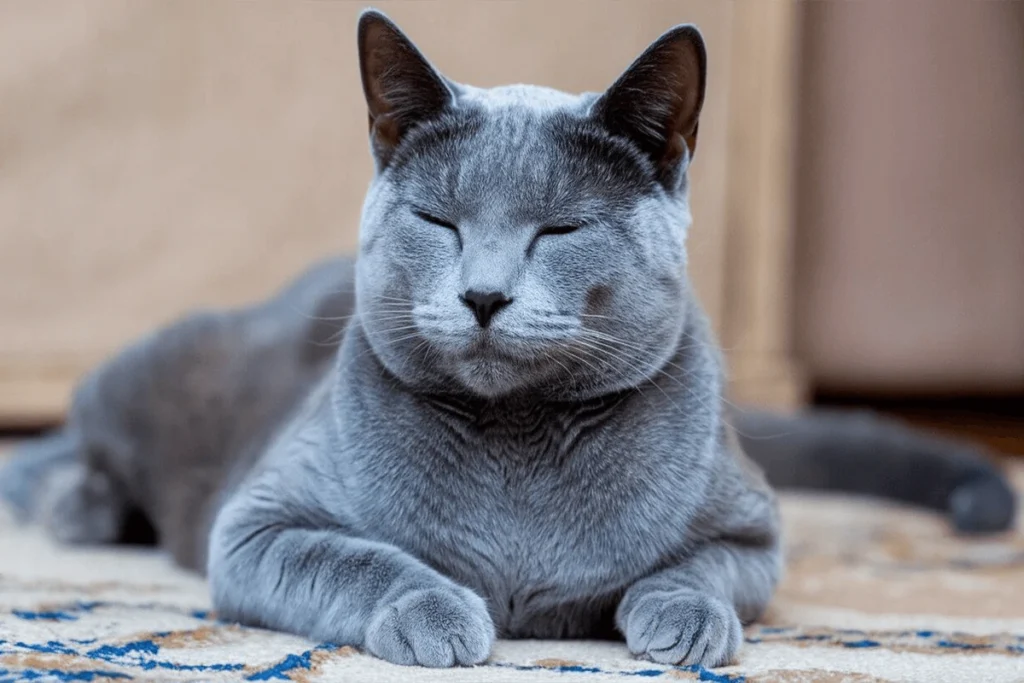
Russian Blue cats captivate pet lovers with their stunning silvery-blue coats, vivid green eyes, and affectionate nature. Owning one means more than just enjoying their elegance—it’s about ensuring their health and happiness through proper care, therefor having a good knowledge about Russian Blue cat health Issues. These intelligent and playful companions deserve an environment where they can thrive.
Caring for a Russian Blue involves understanding their unique health needs, recognizing early signs of Russian Blue cat health Issues, and taking proactive measures to prevent common issues. This guide will walk you through essential tips on nutrition, grooming, veterinary care, and creating a healthy environment. By prioritizing their wellness, you can help your Russian Blue live a long, healthy, and joyful life.
Understanding The Russian Blue cat health Issues
Russian Blue-Specific Health Concerns
Russian Blue cats are generally healthy, but like any breed, they can face specific health challenges. One common issue is obesity, as these cats tend to have a hearty appetite and a relatively sedentary lifestyle if not encouraged to stay active. Obesity can lead to complications such as diabetes, joint issues, and heart problems.
Another concern involves urinary tract health. Russian Blues are prone to urinary crystals or blockages, especially if they don’t drink enough water. Feeding them a high-moisture diet and ensuring access to fresh water can help reduce this risk.
Lastly, while Russian Blues aren’t known for genetic diseases, their dense coat can sometimes cause overheating in warmer climates. Ensure they have a cool, shaded space during hot weather to prevent heat stress.
Signs of the Russian Blue cat health Issues
Recognizing early signs of illness in your Russian Blue can make a significant difference in their treatment and recovery. Common symptoms include:
- Changes in Appetite: Eating too much, too little, or showing a sudden disinterest in food could signal digestive issues or other health problems.
- Lethargy or Reduced Activity: While Russian Blues are naturally calm, noticeable drops in energy levels may point to illness.
- Respiratory Symptoms: Coughing, sneezing, or labored breathing can indicate feline respiratory infections.
- Behavioral Changes: Hiding, aggression, or excessive vocalization might suggest pain or discomfort.
- Weight Changes: Unexplained weight loss or gain should never be ignored, as it could indicate underlying health concerns like thyroid issues or diabetes.
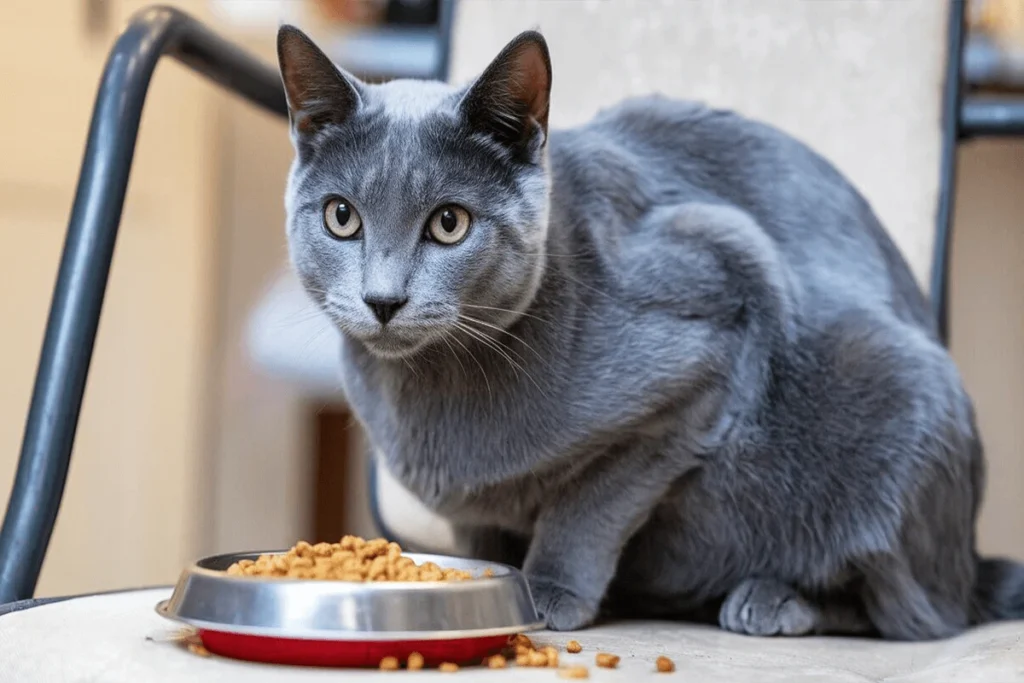
By staying observant and addressing these symptoms promptly, you can provide timely medical intervention and ensure your cat’s well-being.
Preventing Russian Blue cat health Issues Early
Preventive care plays a crucial role in keeping your Russian Blue cat healthy. Begin with regular veterinary visits to monitor their overall health and detect potential issues early. Your vet can conduct routine exams, including checking teeth, ears, and eyes, as well as running diagnostic tests like blood panels or urine analyses.
Diet also serves as a cornerstone of prevention. Provide a balanced, high-quality diet suited to their needs, and avoid overfeeding to prevent obesity. Focus on hydration by incorporating wet food into their diet or using a cat fountain to encourage drinking.
Additionally, ensure their environment supports their physical and mental well-being. Provide opportunities for exercise through toys, climbing trees, and interactive play to keep them active and prevent weight-related issues. Parasite control, such as flea and tick prevention, further reduces the risk of external and internal health complications.
By combining regular check-ups, a proper diet, and a stimulating environment, you can minimize health risks and help your Russian Blue enjoy a long, healthy life.
Providing the Best Nutrition for Your Russian Blue Cat
Healthy Diet Essentials
A healthy diet forms the foundation of your Russian Blue cat’s overall well-being. These cats thrive on a diet rich in high-quality protein to support their lean muscles and active metabolism. Look for cat food where animal-based proteins, like chicken, fish, or turkey, are the primary ingredients.
In addition to protein, healthy fats like omega-3 and omega-6 fatty acids contribute to their glossy coats and promote skin health. Avoid foods with excessive carbohydrates, artificial additives, or fillers, as these provide little nutritional value and may contribute to weight gain.
Russian Blues may also benefit from a tailored diet, such as one designed for indoor cats or those prone to weight gain. Consider consulting with your veterinarian to select the best formula for your cat’s specific needs, whether they’re a kitten, adult, or senior.
Avoiding Common Dietary Mistakes
Feeding your Russian Blue the wrong types or quantities of food can lead to health issues over time. One common mistake is overfeeding. Russian Blues are known for their hearty appetites, but free-feeding (leaving food out all day) can quickly lead to obesity. Instead, stick to measured portions based on your cat’s weight and activity level.
Another mistake involves giving human food as treats. Many common human foods, such as chocolate, onions, garlic, and even dairy, can be toxic or hard to digest for cats. If you want to treat your Russian Blue, choose cat-safe options or vet-recommended treats.
Finally, some cat owners rely too heavily on dry kibble, which may lack the moisture content needed for optimal urinary and kidney health. While dry food is convenient, balance it with high-quality wet food to meet your cat’s hydration needs.
Hydration and Feeding Schedule Tips
Hydration is essential for preventing urinary tract issues and keeping your Russian Blue in peak health. Cats, by nature, have a low thirst drive, so you’ll need to encourage water consumption. Provide fresh, clean water daily and consider using a pet water fountain to make drinking more appealing. Wet food is another excellent way to increase their moisture intake, especially for cats that don’t drink enough water.
Establishing a feeding schedule helps regulate your cat’s metabolism and prevents overeating. Feed your Russian Blue two to three times a day at consistent times. This routine helps maintain a healthy weight and creates a sense of security for your cat.
Additionally, avoid feeding just before bedtime to prevent nighttime begging or hyperactivity. Stick to a balance of wet and dry food for optimal nutrition, and monitor your cat’s eating habits for any sudden changes, as these could indicate underlying health concerns.
By prioritizing proper nutrition, portion control, and hydration, you set your Russian Blue up for a long and healthy life.
Grooming and Hygiene for Optimal Health
Brushing and Fur Maintenance
Russian Blue cats have a dense double coat that gives them their signature velvety texture. While they are low-maintenance compared to some long-haired breeds, regular brushing is essential to keep their coat healthy and minimize shedding. Aim to brush your Russian Blue at least once or twice a week using a soft-bristle or rubber grooming brush.
Brushing not only removes loose fur but also helps distribute natural oils throughout their coat, promoting a healthy shine. During seasonal changes, when shedding may increase, you might need to brush more frequently to manage excess hair and prevent matting.
Pay attention to areas where fur can become tangled, like around the neck and behind the ears. Regular grooming sessions also allow you to check for skin issues, such as dryness, irritation, or bumps, that may require veterinary attention.
Dental Care for Cats
One of the Most Common Russian Blue cat health Issues is “Dental health”. It is often overlooked but is vital for your Russian Blue’s overall well-being. These problems, such as gum disease or tooth decay, can lead to pain, difficulty eating, and even systemic infections if left untreated.
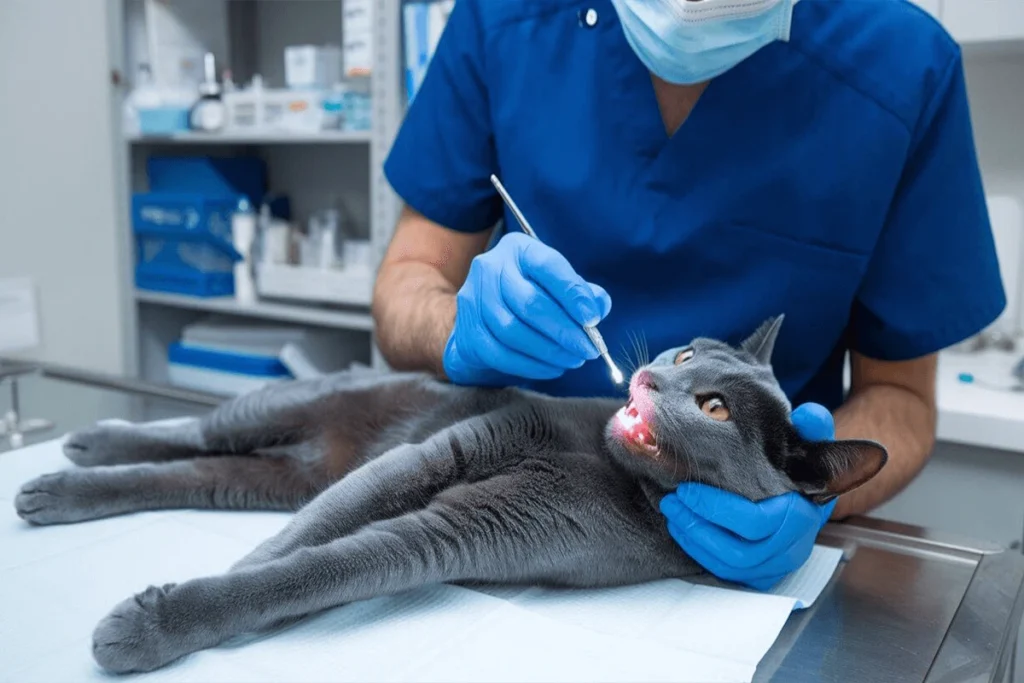
Start a dental care routine by brushing your cat’s teeth two to three times a week using a cat-specific toothbrush and toothpaste. Never use human toothpaste, as it contains ingredients that can be harmful to cats.
In addition to brushing, provide dental treats and toys designed to reduce plaque and tartar buildup. Some cat foods are formulated to support oral health by gently scrubbing the teeth as your cat chews.
Regular veterinary dental check-ups and cleanings are also essential. These visits allow your vet to assess your cat’s oral health and address any issues, such as loose teeth or infections, before they escalate.
Parasite Prevention and Control Prevents Russian Blue cat health Issues
Parasites, such as fleas, ticks, and worms, can affect your Russian Blue’s health and comfort if not managed proactively. These pests can lead to itching, skin infections, anemia, or more severe health issues, including the transmission of diseases.
For external parasites like fleas and ticks, use vet-recommended topical treatments, collars, or oral medications to provide effective protection. Always follow the dosage and application guidelines to avoid under-treating or over-medicating.
For internal parasites like roundworms or tapeworms, ensure your cat receives regular deworming treatments, especially if they go outdoors or have contact with other animals.
Keep your cat’s living environment clean by washing bedding regularly, vacuuming frequently, and treating your home if you notice a flea infestation.
Year-round prevention is key, even if your cat stays indoors. Parasites can enter your home on shoes, other pets, or even through windows. Regular vet check-ups and preventive treatments help protect your Russian Blue from these potential threats, ensuring they stay comfortable and healthy.
By focusing on grooming, dental care, and parasite prevention, you can significantly enhance your Russian Blue’s quality of life and reduce the risk of health problems.
Scheduling Regular Veterinary Visits
Routine Wellness Checks
Routine wellness checks are a cornerstone of your Russian Blue cat’s health. These annual or biannual visits allow your veterinarian to monitor your cat’s overall condition and detect potential health issues early. During a wellness check, the vet examines your cat’s weight, coat, skin, eyes, ears, teeth, and general behavior.
Weight monitoring is crucial for Russian Blues, as they can be prone to obesity. The vet can recommend dietary adjustments or exercise routines to maintain a healthy weight. Additionally, routine checks include inspecting the coat for signs of parasites, skin problems, or nutritional deficiencies.
Behavioral changes or subtle symptoms that may not seem alarming to you could signal underlying health problems. Your vet’s trained eye can pick up on these nuances and recommend further tests or preventive measures if necessary.
Vaccinations and Preventive Care
Vaccinations play a critical role in protecting your Russian Blue cat from infectious diseases. Core vaccines, such as those for feline panleukopenia (distemper), feline herpesvirus, calicivirus, and rabies, are essential for all cats, regardless of whether they live indoors or outdoors.
For Russian Blues that may have some outdoor exposure, your vet may also recommend non-core vaccines, such as those for feline leukemia virus (FeLV) or Bordetella. These vaccines help shield your cat from specific risks they might encounter.
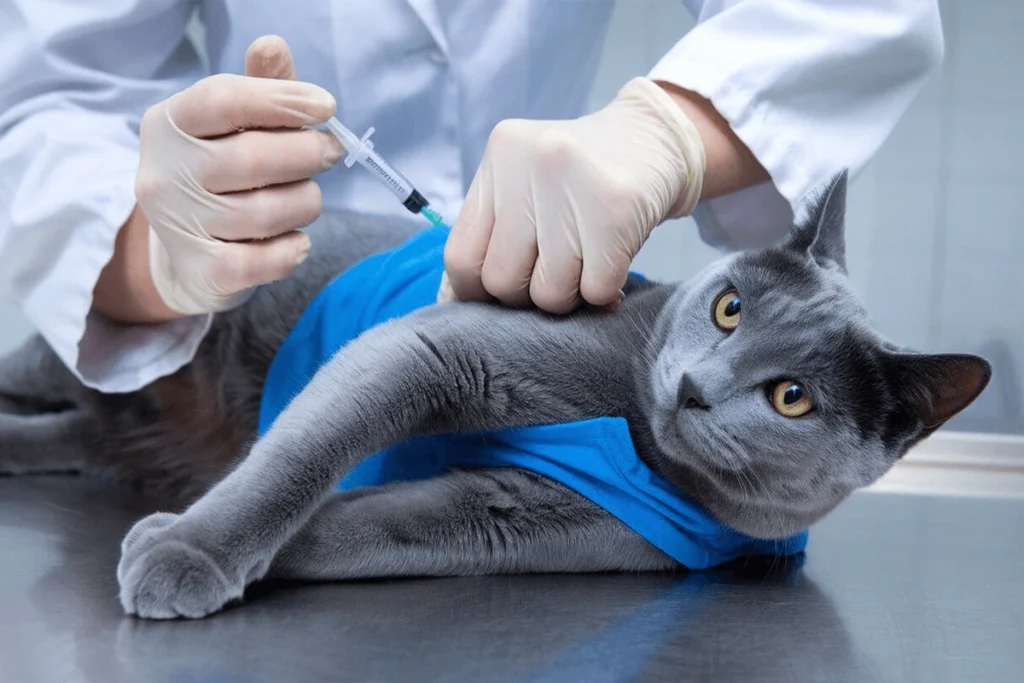
Preventive care extends beyond vaccinations. Routine deworming, flea and tick prevention, and heartworm protection should also be part of your cat’s health regimen. Discuss a tailored prevention plan with your vet based on your cat’s age, lifestyle, and environment. Consistent preventive care not only keeps your cat healthy but also reduces the risk of expensive treatments down the line.
Feline-Specific Diagnostic Tests
Diagnostic tests provide valuable insights into your Russian Blue’s internal health and help identify potential issues before symptoms appear. Common tests include:
- Blood Panels: These tests assess organ function, check for infections, and detect conditions like diabetes or hyperthyroidism.
- Urinalysis: This test evaluates kidney function and screens for urinary tract infections, crystals, or bladder stones, which Russian Blues can be prone to.
- Fecal Examination: This test identifies internal parasites like worms or protozoa and ensures your cat’s digestive system is healthy.
- Dental X-Rays: If your cat shows signs of oral discomfort, dental X-rays can reveal issues such as tooth decay, fractures, or infections beneath the gumline.
- Imaging Studies: X-rays or ultrasounds may be recommended to investigate concerns like unexplained weight loss, respiratory issues, or abdominal discomfort.
Regular diagnostic testing becomes increasingly important as your cat ages, as senior cats are more prone to developing chronic conditions. Discuss with your vet how often these tests should be performed based on your cat’s stage of life and health history.
By prioritizing routine wellness checks, vaccinations, and diagnostic tests, you can give your Pet the best chance at a long, healthy life And Prevent the Russian Blue cat health Issues.
Creating a Healthy Environment for Your Russian Blue
Stress-Free Living Spaces
Russian Blue cats are known for their calm and affectionate nature, but they can be sensitive to changes or disruptions in their environment. Creating a stress-free living space is vital for their emotional and physical well-being.
Start by providing a quiet and secure area where your cat can retreat when feeling overwhelmed. A cozy bed, a soft blanket, or a secluded corner of the house can serve as their personal sanctuary. Cats thrive in environments with consistency, so try to maintain a stable routine for feeding, playtime, and grooming.
Ensure that your home remains a calm and harmonious space by minimizing loud noises and sudden disturbances, such as loud appliances or frequent visitors. If you have multiple pets, create separate feeding and resting areas to prevent competition or stress.
Adding vertical spaces, like cat trees or wall-mounted shelves, allows your Russian Blue to perch and observe their surroundings, which can help them feel more secure and in control of their environment.
Exercise and Enrichment Activities Can prevent Russian Blue cat health Issues
Russian Blue cats are naturally playful and intelligent, and they require regular physical and mental stimulation to stay healthy and happy. Without enough exercise, they may become bored, stressed, or even overweight.
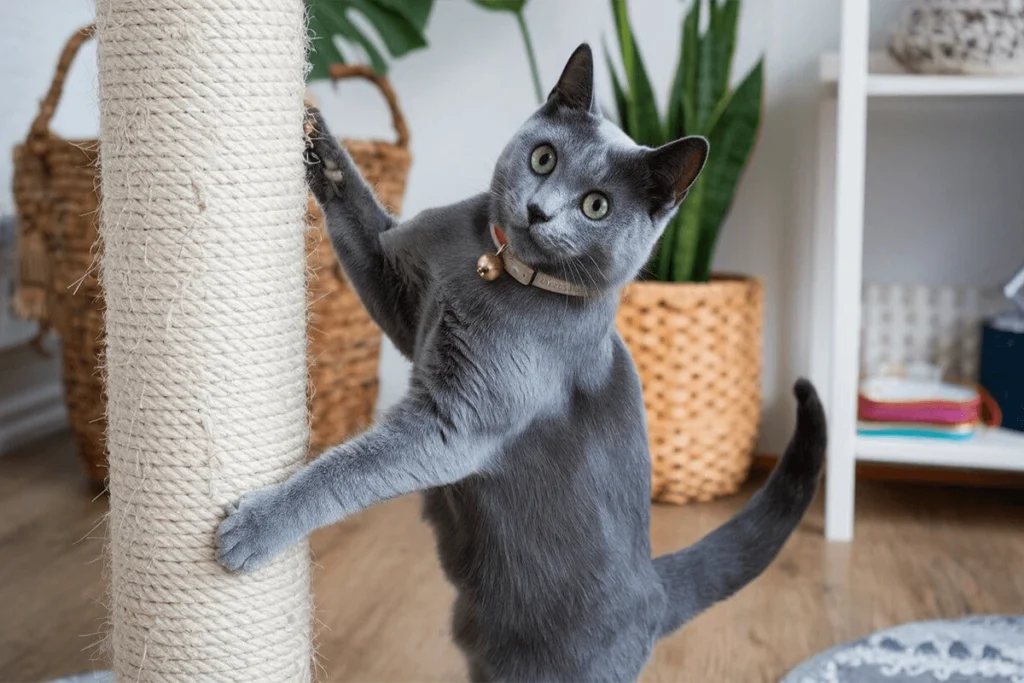
Encourage daily play sessions using toys that mimic prey, such as feather wands, laser pointers, or small balls. Interactive toys that dispense treats or require problem-solving can keep them engaged and mentally stimulated.
Provide climbing opportunities like cat trees, scratching posts, or wall-mounted climbing systems to encourage physical activity. These structures also help satisfy their instinctual need to scratch and mark territory.
Rotate toys regularly to keep your cat interested and curious. You can also introduce puzzle feeders, which combine mealtime with enrichment, slowing down their eating while engaging their minds.
For additional stimulation, consider setting up a window perch where your cat can watch birds, squirrels, or outdoor activity. If you have a safe outdoor space, supervised leash walks or a secure catio can provide fresh air and exploration opportunities.
Minimizing Exposure to Hazards
A safe environment is essential for protecting your Russian Blue from potential hazards. Start by securing your home against common risks:
- Remove Toxic Plants: Many household plants, such as lilies, philodendrons, and pothos, are toxic to cats. Replace them with cat-safe alternatives like spider plants or cat grass.
- Store Harmful Substances Safely: Keep cleaning products, medications, and chemicals locked away in cabinets or out of your cat’s reach.
- Pet-Proof Your Home: Cover electrical cords, secure trash bins, and ensure windows and balconies are cat-proofed to prevent accidents.
- Monitor Small Objects: Items like rubber bands, string, or small toys can pose choking hazards or cause blockages if swallowed.
For indoor cats, prevent door-dashing by creating a buffer zone near entryways or training them to avoid these areas. If your Russian Blue has access to the outdoors, ensure the area is secure and free from potential dangers like traffic, predators, or harmful substances.
By taking these precautions, you can provide a safe, enriching, and low-stress environment where your Russian Blue cat can thrive physically and emotionally.
Conclusion
Taking care of a Russian Blue cat means more than just meeting their basic needs—it’s about fostering a lifestyle that ensures their health, happiness, and longevity. By staying proactive, you can prevent many common health issues and address problems early, giving your cat the best chance at a vibrant and active life.
Focus on providing a balanced diet rich in high-quality proteins, keeping their hydration levels in check, and avoiding overfeeding. Regular grooming sessions not only maintain their sleek, beautiful coat but also allow you to monitor their skin and overall condition. Preventive measures, such as parasite control, vaccinations, and routine vet visits, play a critical role in keeping them healthy.
Make their environment a haven where they feel safe and loved. Provide opportunities for exercise and mental enrichment to keep their minds sharp and their bodies active. Reduce stress by maintaining a consistent routine and ensuring their surroundings are free from hazards.
Your attention to these details doesn’t just keep your Russian Blue cat health Issues away; it strengthens the bond you share with them. Cats sense the love and care their owners provide, and a happy, healthy cat brings joy to every home. Commit to their well-being, and you’ll enjoy years of companionship with your elegant and affectionate Russian Blue.
Learn More About the Russian Blue Cat Here!
You Can find some good stuff on The Pet MD Official
